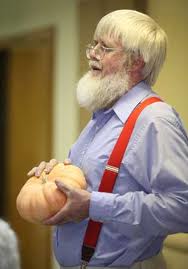by Audrey Scharmen
Published in Potomac Review, Fall/Winter 2001-02.
In the aftermath of lighting, thunder and a heavy downpour with the horizon streaking rose, and mauve, tall silhouettes of trees encircle a dooryard garden where the cardinal flower stands amid a bed of her offspring. She is regal and rainswept, unbowed by the storm, each scarlet spike of florets beaded with diamond droplets aglitter in the fading light.

Lobelia cardinalis, older than time, the symbol of hope and continuity in an era when both are precarious, has chosen this garden of a herbalist and healer as a sanctuary. Here are boneset, lion’s foot and agrimony. Argiope spins silver among cats claw and zebra grasses where winged Luna and Promethea linger to meditate and metamorphose. Here is a strident chorus of tree frogs and birdsong, the fecund scent of a generous season, and the subtle fragrance of white sage burned in an ancient ritual of welcome.
Lobelia cardinals, older than time, the symbol of hope and continuity in an era when both are precarious, has chosen this garden of a herbalist and healer as a sanctuary. Here are boneset, lion’s foot and agrimony. Argiope spins silver among cats claw and zebra grasses where winged Luna and Promethea linger to meditate and metamorphose. Here is a strident chorus of tree frogs and birdsong, the fecund scent of a generous season, and the subtle fragrance of white sage burned in an ancient ritual of welcome.
The gardener, who presides with the blessings of the natural world, describes an entourage of daddy longlegs spiders that came to spread a net about the cardinal’s buds when predators threatened. The spiders quietly retreated when the first flowers opened, and the plant remains flawless. She tells of hummingbirds who came to pollinate-among the few winged creatures able to penetrate the deep nectar of the florets-and of a fat bumblebee who sleeps nightly amid the blossoms.
And she tells of the cardinal’s coming. To this thickly wooded acreage that she has long tended in the watershed of a great estuary, where precious fossils of an inland sea abound, and where relics of Piscataway Indians who once hunted here lie all about, have come uncommon botanicals, seeking refuge from the constant threat of progress. But her garden lacked a cardinal flower, an elusive plant she coveted.
It is a stunning survivor of the warm period that preceded the glacial epoch-its flowers so intense a hue the leaves often are stained with it. It is said that no color due to sustained sunlight could have originated in our temperate zone. Thus its birth has been traced to the Age of Flowers, to a sudden explosion that changed the face of Earth. The cardinal indeed may have been present at the creation.
The gardener’s efforts to transplant such a flower had been futile, and she had gone in search of it in a woodland beside the bed of a brook in a nearby glen protected by dense undergrowth and tall trees. Stalks of summer things spoke of a secret garden, and she thought it an ideal place for the Cardinal, a wetland plant with an aura of the rain forest, which craves a secluded habitat where it may keep its feet wet and its head crowned with sunlight. Hidden beneath a residue of autumn past were infant seedlings resembling those of the cardinal-flat green rosettes of leaves with baby fuzz still intact. But she was uncertain so she would return later when jewelweed and goldenrod bloom, in the time of the cardinal.
Fate intervened. A few weeks later four young people died instantly in a head-on collision beside the road that borders the woodland, steps away from a trail that leads down to a haven of seedlings. An entire community mourned, and the crash site became a shrine. Candlelight vigils were held there, and paper roses bloomed beside a white cross with photos of four smiling faces forever sixteen. The gardener considered the glen a temporary haven for the transitory souls of the children and so she did not return.
Autumn faded; winter turned quickly cruel, and the wilted roses shed red on new fallen snow. Spring came early with clouds of dogwood to grace the shrine. Chaste stars of Bethlehem shone on the hillside, and burgeoning foliage hid the path beyond from the eyes of passerby. Summer followed long and sweltering. No rain fell and the wetlands withered.
With late summer came rain, the heat subsided, Virginia creeper and sumac bled scarlet beside the road, and white blossoms of autumn clematis covered the carnage of drought. A semblance of peace came to the shrine, and the gardener returned to the glen. But the Cardinal hadn’t come. Black-eyed Susans bloomedin its place.
In early September it appeared in her garden-rising from tall stalks of feverfew and ferns beside the porch, undetected until a bright beacon of buds reviewed the presence. A rare albino deer had come, as well, to linger briefly at the woods edge, pale and ghostly in the blue twilight. Hummingbirds returned-none had been seen all that summer.
There is no explanation. Perhaps a single seed, dormant for centuries nurtured by one of many springs known to lie deep beneath the unique woodland, suddenly had awakened. It was the cardinal’s time.
